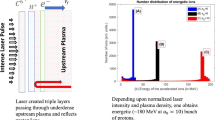Abstract
A solution of the two-dimensional problem is presented for a transverse rarefaction wave of a plane layer behind a wavefront of nonlinear thermal conductivity produced by an instantaneous cylindrical energy source with its axis normal to the layer surface. The matter can rarefy through the free surfaces of the layer or through holes in the boundary walls, which are coaxial with the energy source axis. Analytic solutions are obtained describing the formation of the rear boundary in the heated zone due to transverse matter rarefaction. The energy fraction transferred to the energy of hydrodynamic motion is also determined.
Models of plasma formation inside the inner target cavity under the action of pulsed energy sources are considered as applications of the approach suggested. Requirements on the source and target parameters are formulated for efficient matter heating with minimum energy losses caused by hydrodynamic rarefaction of the matter.
Similar content being viewed by others
References
R. E. Marshak,Phys. Fluids,1, 24 (1958).
Ya. B. Zel’dovich and Yu. P. Raizer,Physics of Shock Waves and High-Temperature Hydrodynamic Phenomena, Academic Press, New York (1967).
A. A. Samarskii, S. P. Kurdyumov, and P. P. Volosevich,Zh. Vych. Mat. & Matem. Fiz.,5, 199 (1965).
P. P. Volosevich, S. P. Kurdyumov, and E. I. Levanov,Prikl. Mekh. Tekhn. Fiz.,5, 41 (1972).
V. V. Neuvazhaev,Prikl. Mat. Mekh.,30, 1015 (1966).
Yu. V. Afanas’ev, V. M. Krol’, O. N. Krokhin, and I. V. Nemchinov,Prikl. Mekh. Tekhn. Fiz.,30, 1022 (1966).
J. Nuccols,Physics Today,9, 25 (1982).
S. Nakai,Nuclear Fusion,30, 1779 (1990).
S. Yu. Gus’kov, N. V. Zmitrenko and V. B. Rozanov,Zh. Éksp. Teor. Fiz.,81, 296 (1995).
S. Yu. Gus’kov and L. P. Feoktistov,Pis’ma Zh. Éksp. Teor. Fiz.,66 823 (1997).
S. Yu. Gus’kov, V. V. Zverev, and V. B. Rozanov,Sov. J. Quantum Electron.,13, 498 (1983).
A. P. Fews, P. A. Norreys, A. E. Dabgor et al., “High fusion yields from picosecond laser irradiated target,” in:Central Laser Facility, Rutherford Appleton Laboratory, Annual Report 1994–1995, RAL-TR-95-025, p. 30.
Author information
Authors and Affiliations
Additional information
Translated from Preprint No. 14 of the P. N. Lebedev Physical Institute, Moscow (1998).
Rights and permissions
About this article
Cite this article
Gus’kov, S.Y., Doskach, I.Y. Transverse rarefaction of a layer behind the front of a longitudinal wave of nonlinear thermal conductivity and features of plasma formation inside the target cavity. J Russ Laser Res 19, 581–600 (1998). https://doi.org/10.1007/BF02559666
Published:
Issue Date:
DOI: https://doi.org/10.1007/BF02559666




